Since the Society of the Cincinnati’s founding in 1783, its medals and insignia have communicated its founding ideals and mission and commemorated important people and events in its history. Pierre-Charles L’Enfant designed the first two Society medals in 1783: a circular medal bearing scenes of Cincinnatus, which wouldn’t be made for more than one hundred years, and the Society’s bald eagle-shaped insignia, which has enjoyed a long and distinguished history. The centennial of the American Revolution in the late nineteenth century inspired a wave of medals commissioned by the Society and its branches to commemorate battles of the Revolution and the founding of the Society of the Cincinnati. The Society’s Triennial Meetings have been commemorated in medals since 1914—a tradition that has continued, with some gaps, to the modern era.
The insignia of the Society of the Cincinnati is by far the most important and recognized medal associated with the organization. Known as the Eagle, the Society’s insignia celebrates the achievement of American independence and the commitment of those who have worn it to the memory of the Revolution. Typically made of gold with enamel decorations, the Society’s insignia is a double-sided medal in the shape of an American bald eagle bearing depictions of the organization’s namesake, the ancient Roman hero Cincinnatus. With its downturned wings and olive branches in its talons, the Society Eagle emphasizes the founding of a peaceful American republic and the return of its soldiers to their civilian lives.
The Eagle was designed in 1783 by Pierre-Charles L’Enfant, a French-born artist who became an officer in the Continental Army and an original member of the Society. The first Eagles were made under L’Enfant’s direction in early 1784 in Paris, as he considered French craftsmen to be the only ones in the world skilled enough to produce the fine gold-and-enamel medals. L’Enfant contracted with Nicolas Jean Francastel and Claude Jean Autran Duval to make these first 225 Eagles, which were distributed to both American and French members.
American craftsmen soon began making their own versions of the Society insignia, with Jeremiah Andrews of Philadelphia producing the first American-made Eagle in December 1784. Andrews and each craftsman who followed him in making the Eagle introduced their own variations, techniques, and preferences—resulting in more than forty different versions of L’Enfant’s original design, varying in size, metal, and decoration. By the early nineteenth century, silversmiths in Boston and New York City were also making versions of the Society insignia. The heyday of the Eagle’s manufacture came in the late nineteenth century, when eminent firms like Tiffany and Company and Bailey Banks & Biddle created artistic yet precise examples of the Eagle to meet the demand from a rapidly growing membership. Individual constituent societies commissioned their own distinctive patterns of the insignia, several of which are still made today.
With more than seventy historical examples of the Eagle, the Society holds the largest collection of its insignia in the world. Foremost among them is the Diamond Eagle, a jewel-encrusted insignia that French naval officers commissioned for George Washington in 1784 and that became the badge of office of the Society’s president general. This collection documents the significance of the Eagle, and the variety in its designs and makers, over its more than two-hundred-year history.
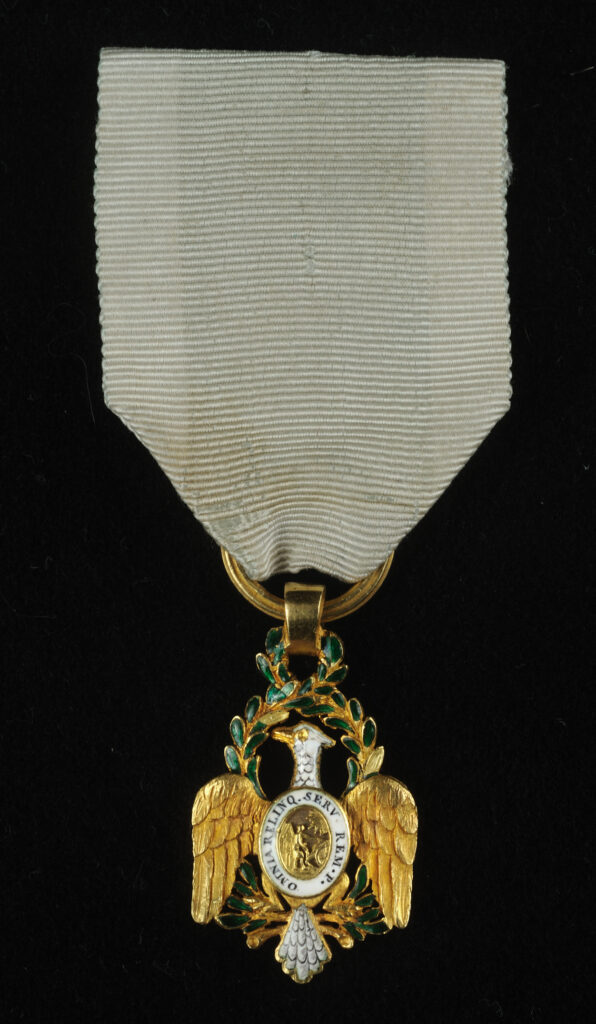
Nicolas Jean Francastel and Claude Jean Autran Duval, Paris, France
1784
Museum Acquisitions Fund purchase, 2013
The first examples of the Society insignia were made in Paris in January 1784 for French members of the Society. Craftsmen Francastel and Duval made forty-five small gold insignias, the first of which were distributed by the marquis de Lafayette at an organizing meeting of the French branch of the Society. This example was owned by the comte de Lauberdière (1759-1837), an aide-de-camp to General Rochambeau.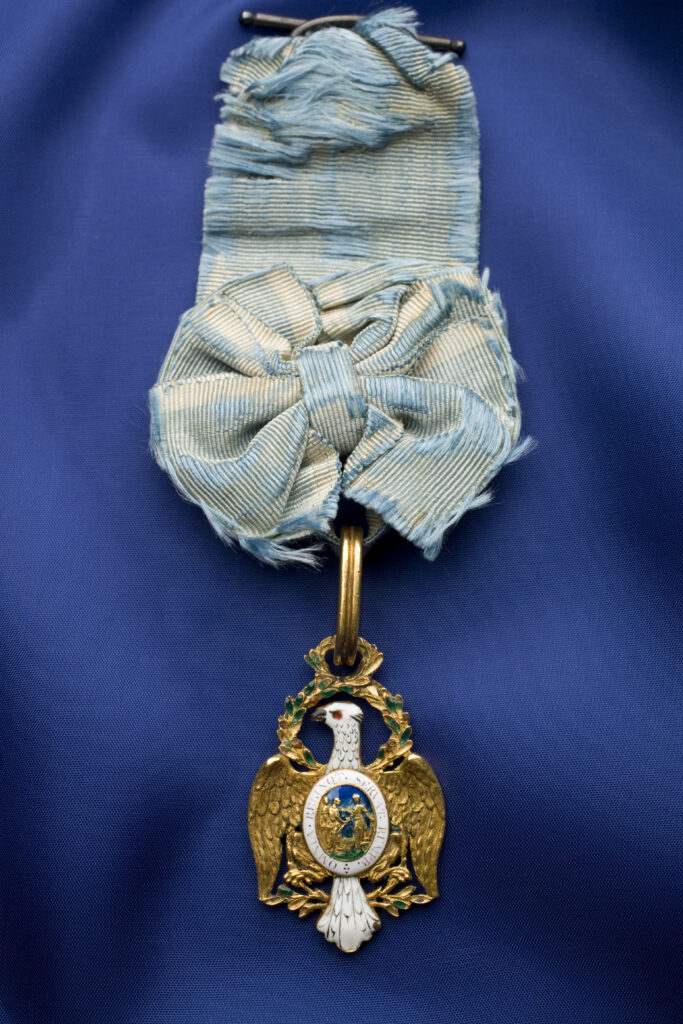
Nicolas Jean Francastel and Claude Jean Autran Duval, Paris, France
1784
Gift of Harrison Tilghman, Society of the Cincinnati of Maryland, 1953
L’Enfant oversaw the production of forty full-size gold insignias to fill subscriptions he received before leaving America, including an order from George Washington for eight Eagles to give to former aides-de-camp who became original Society members. Washington presented this one to Tench Tilghman (1744-1786) of Maryland, to whom the general entrusted the duty of delivering to Congress the Articles of Capitulation after the Siege of Yorktown. Tilghman’s Eagle retains its original silk ribbon and metal clasp.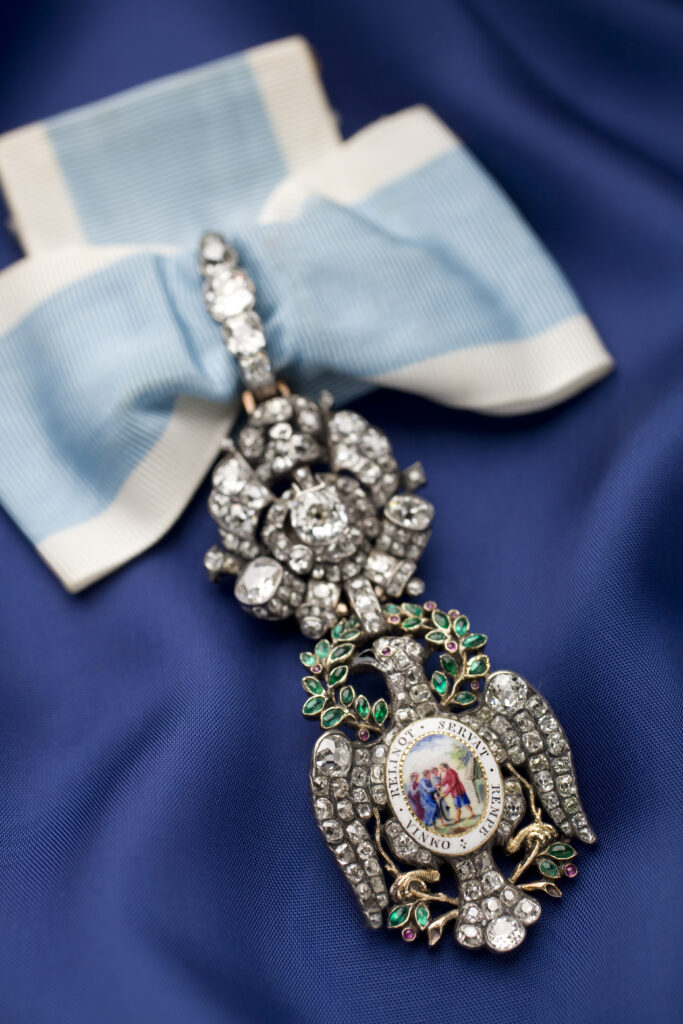
Nicolas Jean Francastel and Claude Jean Autran Duval, Paris, France
1784
Gift of Charles Cotesworth Pinckney, Society of the Cincinnati of the State of South Carolina, 1811
The Diamond Eagle, the badge of the office of the president general, was commissioned by French naval officers who served in the Revolutionary War as a gift for George Washington. Adorned with 198 diamonds, emeralds, and rubies, the Diamond Eagle has been worn by every president general since Washington, including Alexander Hamilton, Charles Cotesworth and Thomas Pinckney, and Hamilton Fish.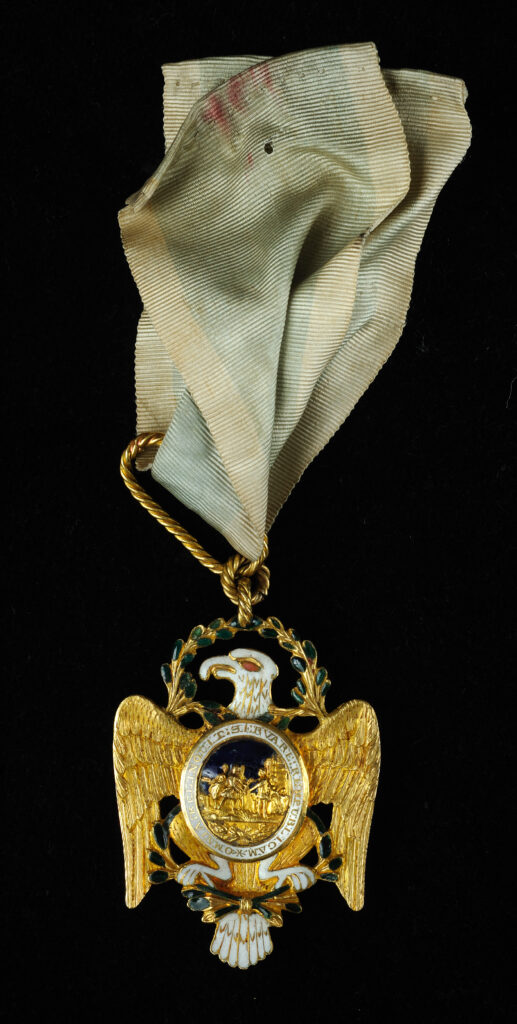
Jeremiah Andrews, Philadelphia, Pa.
ca. 1784-1791
Museum purchase, 2018
Jeremiah Andrews, the first American craftsman to make the Society insignia, sold the Eagle to members from his Philadelphia shop and on trips through the South beginning in December 1784. His design for the gold insignia featured broader wings, a larger head, and more detailed medallion scenes than in the first French Eagles. This example was owned by Allan McLane (1746-1829), a captain of light troops in the Continental Army and an original member of the Delaware Society.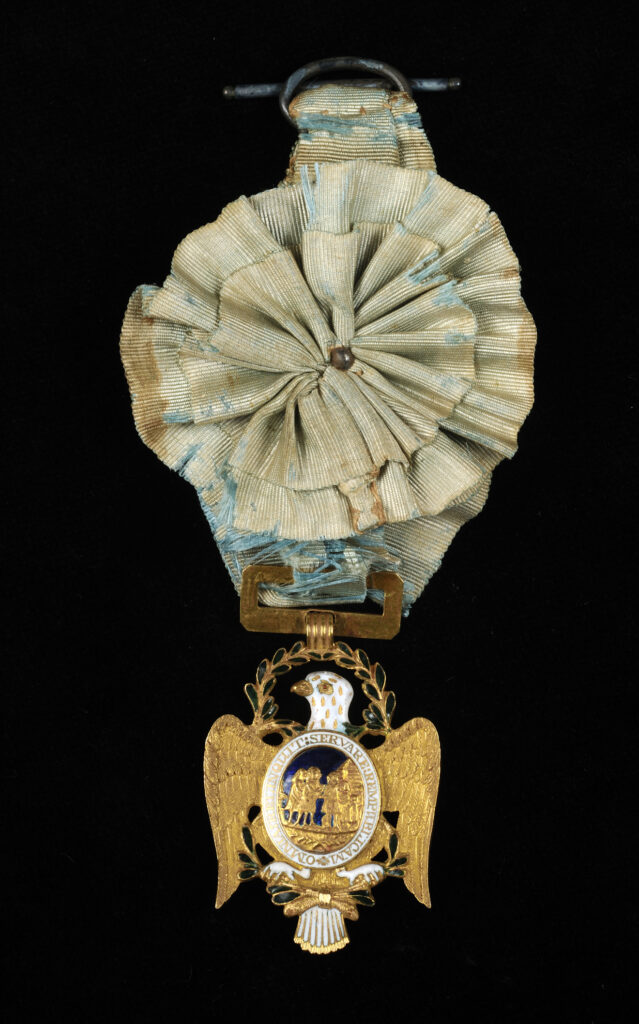
John Cook, New York, N.Y.
1800
Museum Acquisitions Fund purchase, 2013
In the early nineteenth century, the New York Society commissioned Eagles from several silversmiths in New York City. John Cook made this insignia, modeled on Jeremiah Andrews’ design. The New York Society presented it to the Reverend William Linn (1752-1808), a chaplain of the Fifth Pennsylvania Battalion during the Revolutionary War who the New York Society elected an honorary member on February 22, 1800, the same day he delivered a funeral eulogy for George Washington to the group. Linn’s gold Eagle retains its original silk ribbon and metal clasp.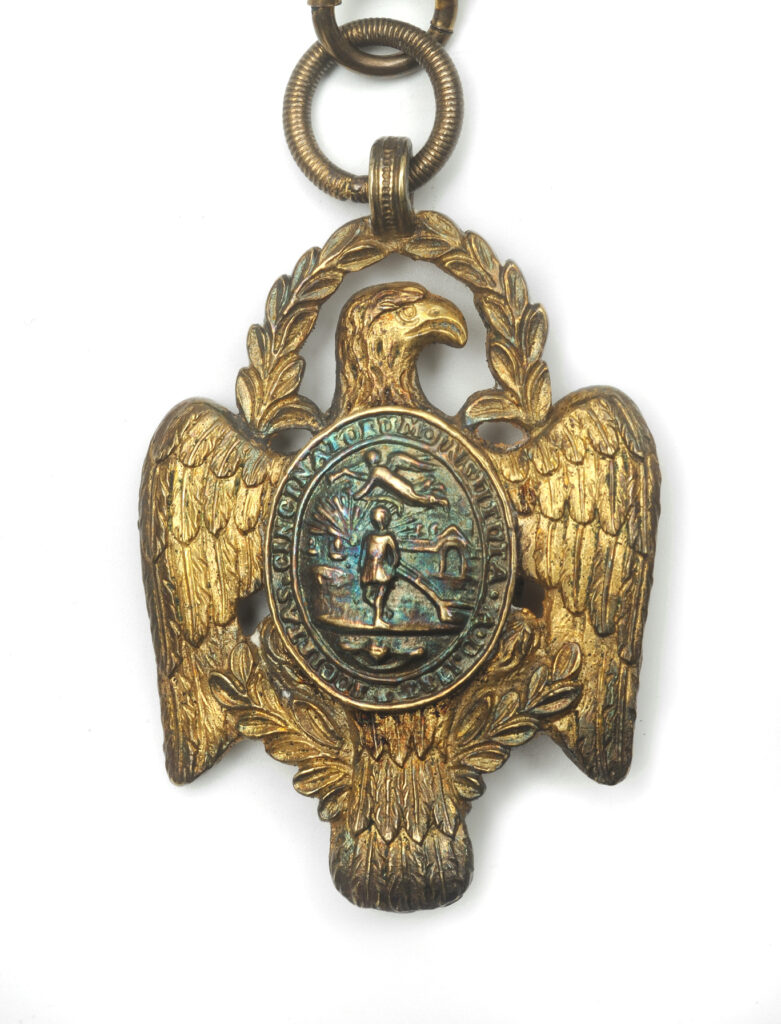
Attributed to Thomas Fletcher, Philadelphia, Pa.
ca. 1821
Gift of Brinton Le Compte, 1997
In 1821 the Rhode Island Society commissioned a new Eagle design from a Philadelphia silversmith, thought to be Thomas Fletcher of the renowned firm Fletcher and Gardiner. Distributed through the 1820s, most of these Eagles were gold-plated coin silver. This example owned by George Washington Cole (1781-1860), a hereditary member of the Rhode Island Society, is one of five early Rhode Island Society Eagles in the Society’s collections. The reverse of the insignia, pictured here, depicts Cincinnatus having returned triumphant to his plow with Fame flying overhead.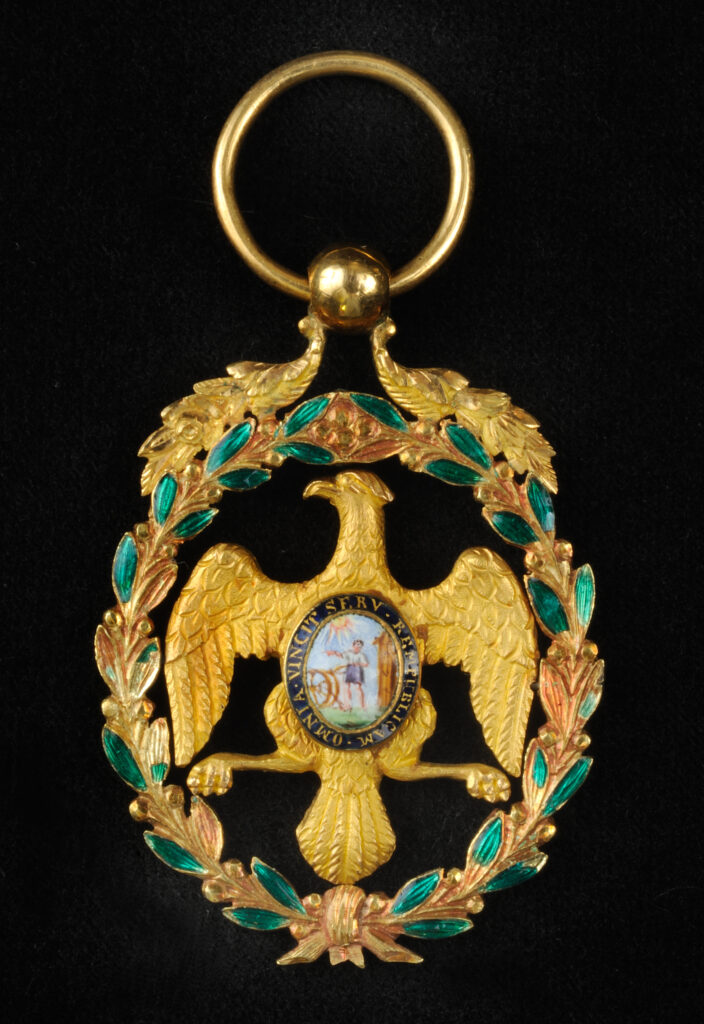
Paris, France
ca. 1830-1832
Gift of the estate of Mabel S. Daveis, 1950
During Lafayette’s visit to Virginia in 1824, George Washington’s adopted granddaughter Eleanor (Nelly) Parke Custis Lewis presented Lafayette with a distinctive Society insignia Washington had owned, which was made under L’Enfant’s direction in Paris in 1784. In 1830, Lafayette gave permission to Charles Stewart Daveis (1788-1865), a member of the Massachusetts Society, to have this gold replica made for Daveis to take with him back to America.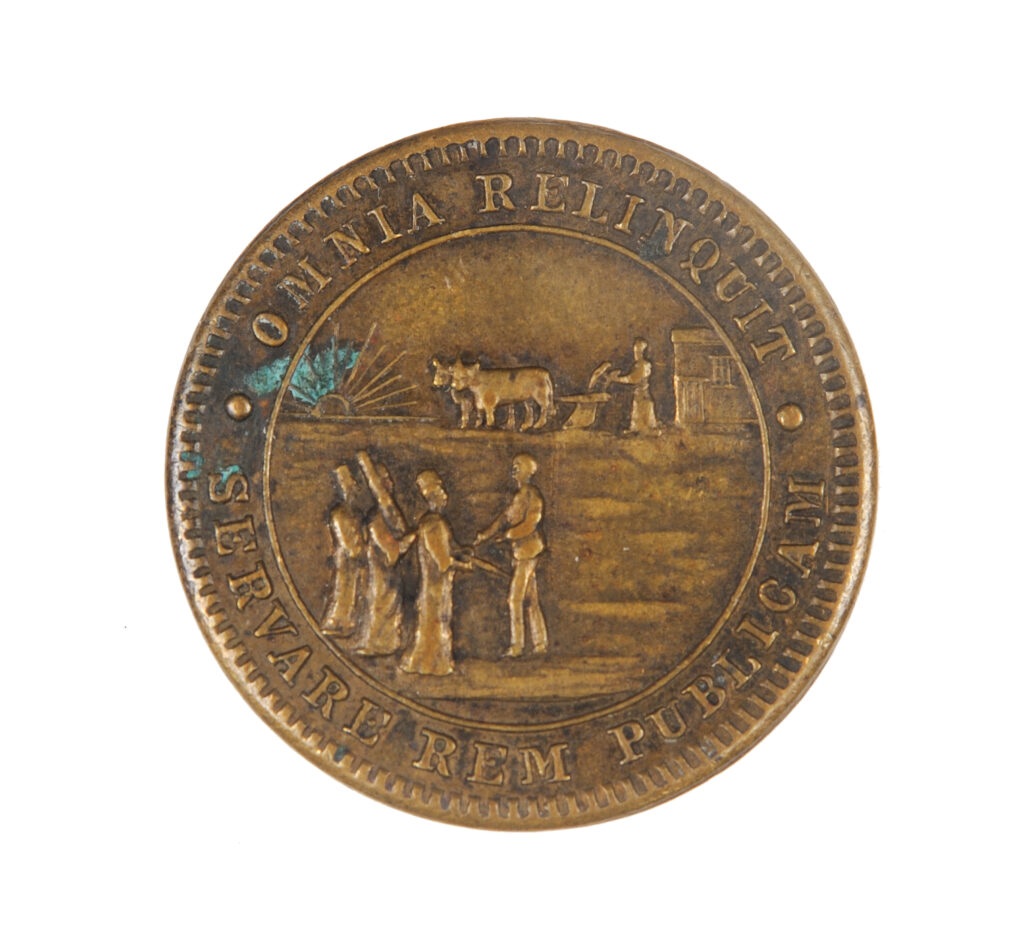
American
ca. 1866-1900
Museum Acquisitions Fund purchase, 2009
This small bronze commemorative medal bears on one side a distinctive scene of three Roman senators presenting a sword to Cincinnatus on his farm, surrounded by the Society of the Cincinnati’s motto. On the other side is the seal of the Grand Army of the Republic, an organization of Union veterans of the Civil War founded in 1866.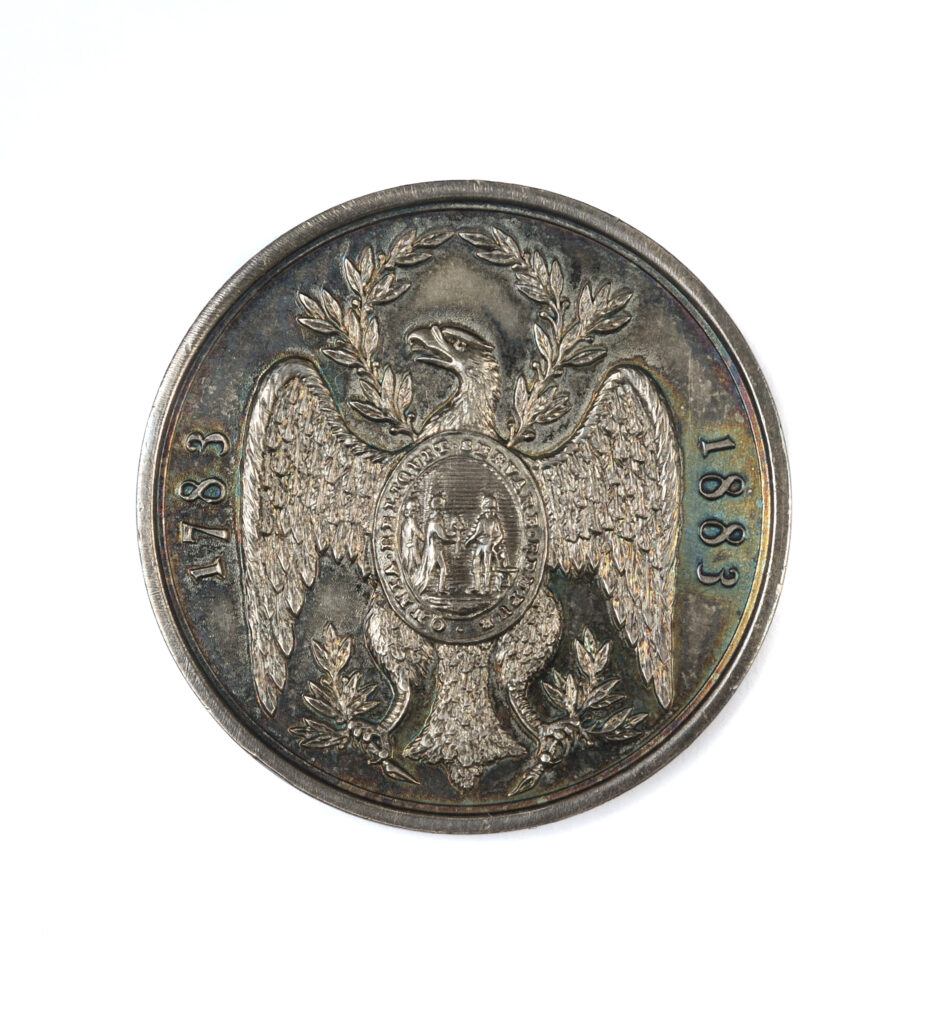
American
ca. 1883
Gift of Bruce W. Regnemer, 2002
The Society commissioned a medal to commemorate its centennial in 1883, depicting the insignia on the obverse (pictured) and laurel and oak branches framing a blank space on the reverse where a member’s name could be engraved. Less than four hundred of these medals were struck in gold, silver, and bronze and sold to members. This silver example was owned by Otho Holland Williams, Jr. (1855-1896), a hereditary member of the Maryland Society and great-grandson of Brigadier General Otho Holland Williams of the Continental Army.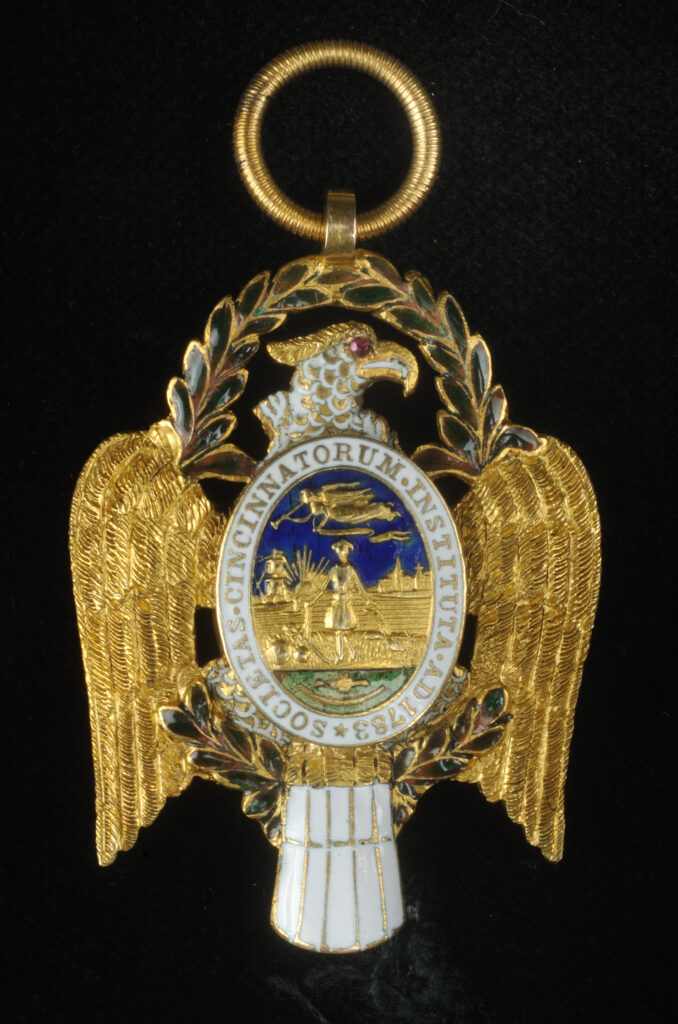
Tiffany and Co., New York, N.Y.
ca. 1885
Gift of Colonel Bryce Metcalf, the Society of the Cincinnati in the State of Connecticut
Tiffany and Co. made several versions of the Society Eagle in the late nineteenth and early twentieth centuries, beginning with this design commissioned by the Rhode Island Society in the late 1870s or early 1880s. The superior goldwork, elegant crested head, and impressive medallion scenes set this and other Tiffany Eagles apart from its contemporaries. This example was owned by Bryce Metcalf (1874-1951), a hereditary member of the Connecticut Society and the Society’s thirteenth president general.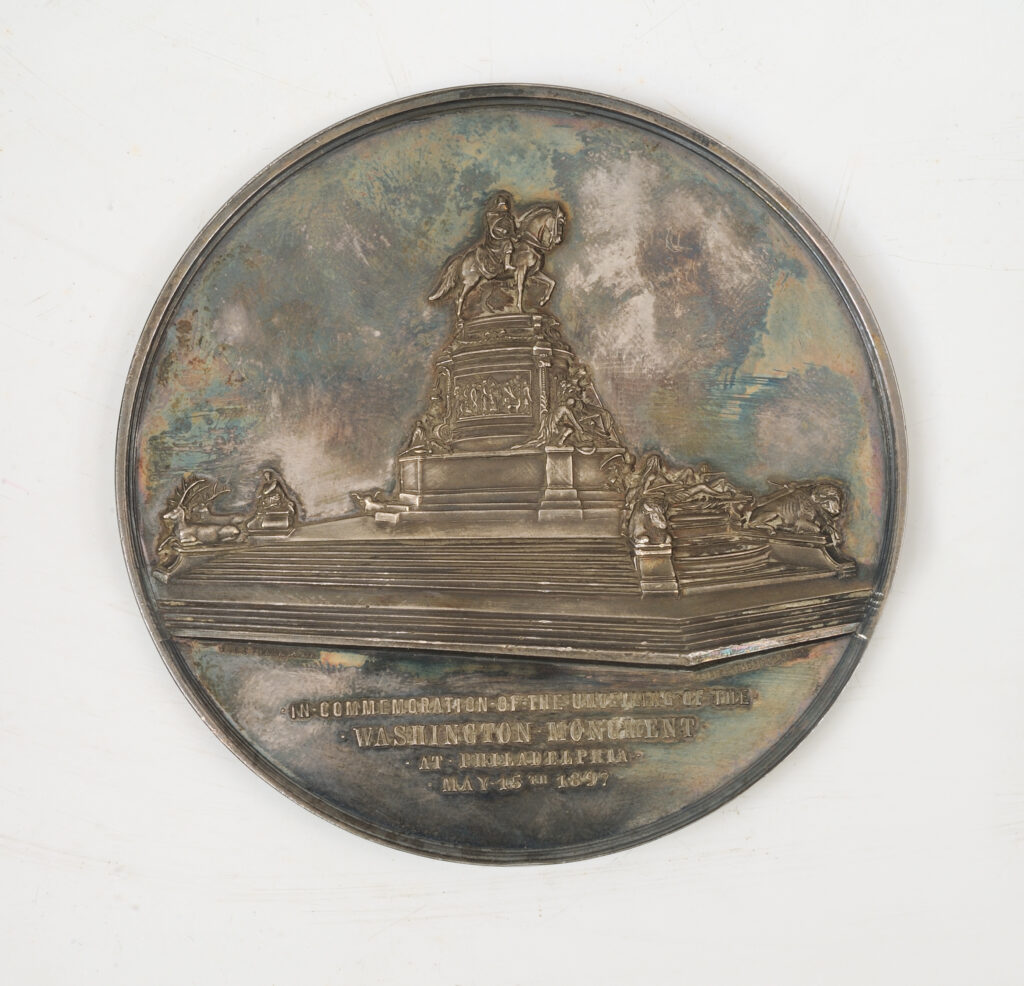
Designed by August C. Frank; Struck by Peter L. Krider Co., Philadelphia, Pa.
1897
Gift of Joseph K. Fornance, State Society of the Cincinnati of Pennsylvania, 1962
In 1881 the Pennsylvania Society commissioned German sculptor Rudolf Siemering to create a large monument to George Washington in Philadelphia. The forty-four-foot tall monument, surmounted by a bronze equestrian statue of Washington, was unveiled in May 1897. The Pennsylvania Society had this silver medal struck to commemorate the occasion, and distributed copies to distinguished guests and members in attendance. The obverse bears the Society insignia and the reverse, pictured here, depicts the monument.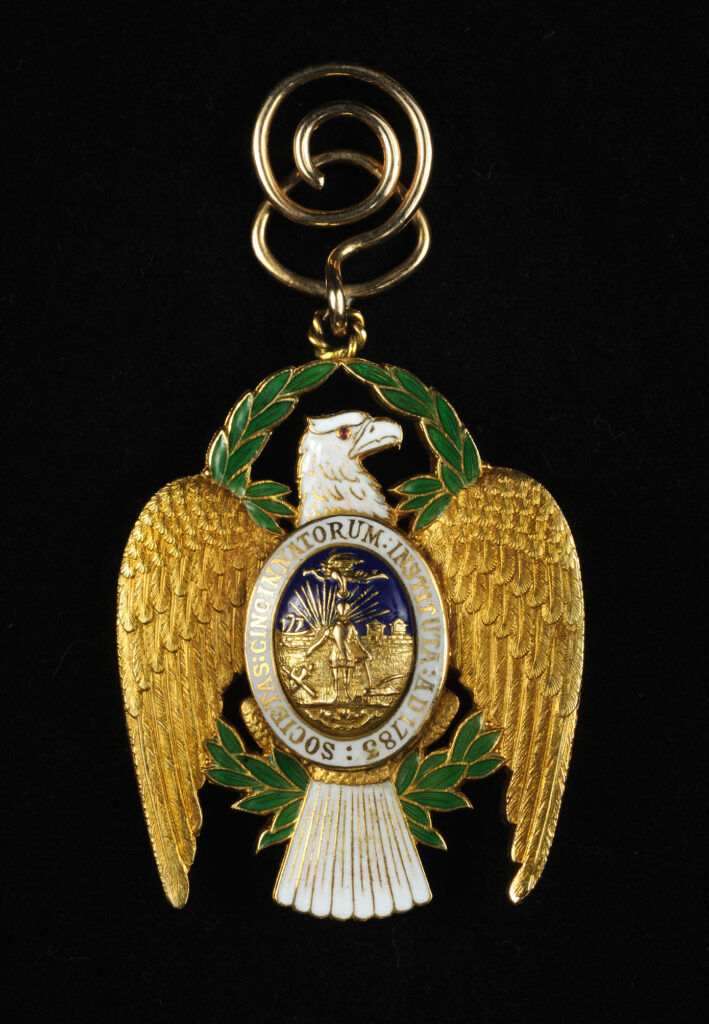
Bailey Banks & Biddle, Philadelphia, Pa.
ca. 1908
Gift of Anne Olney Girard, 1972
At the turn of the twentieth century, the Society attempted to standardize the Eagle design to bring uniformity and consistent quality to its appearance and administration. Bailey Banks & Biddle produced full-size and miniature versions of the Standard Eagle from 1902 to the 1930s, even while different designs continued to be made by other firms. This gold Standard Eagle was owned by Pierre de Stael Olney, a hereditary member of the Rhode Island Society.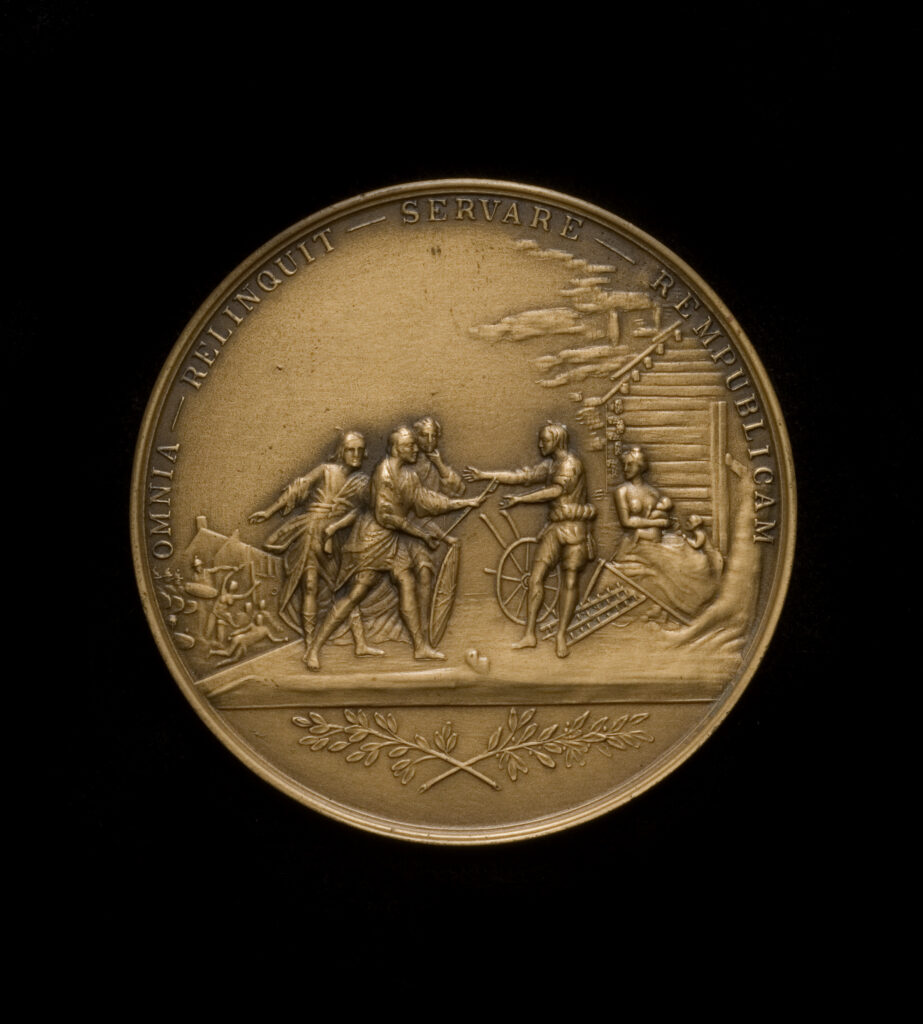
Designed by Pierre-Charles L’Enfant; Struck by Whitehead & Hoag Co., Newark, N.J.
ca. 1914
Gift of Paul Thruston Mackie, Society of the Cincinnati in the State of Virginia, 1959
Shortly after its founding, the Society asked Pierre L’Enfant to design a circular medal bearing the emblems of the organization, but this medal was superseded by the Eagle insignia and was never struck in the founding era. More than one hundred years later, the Maryland Society commissioned a bronze medal based on L’Enfant’s drawings. The medal commemorated the Society’s Triennial Meeting hosted by the Maryland Society in 1914—the beginning of a tradition of Triennial medals produced into the twenty-first century. The obverse, shown here, depicts Cincinnatus receiving his sword from Roman senators as he leaves home to lead his country against its enemies.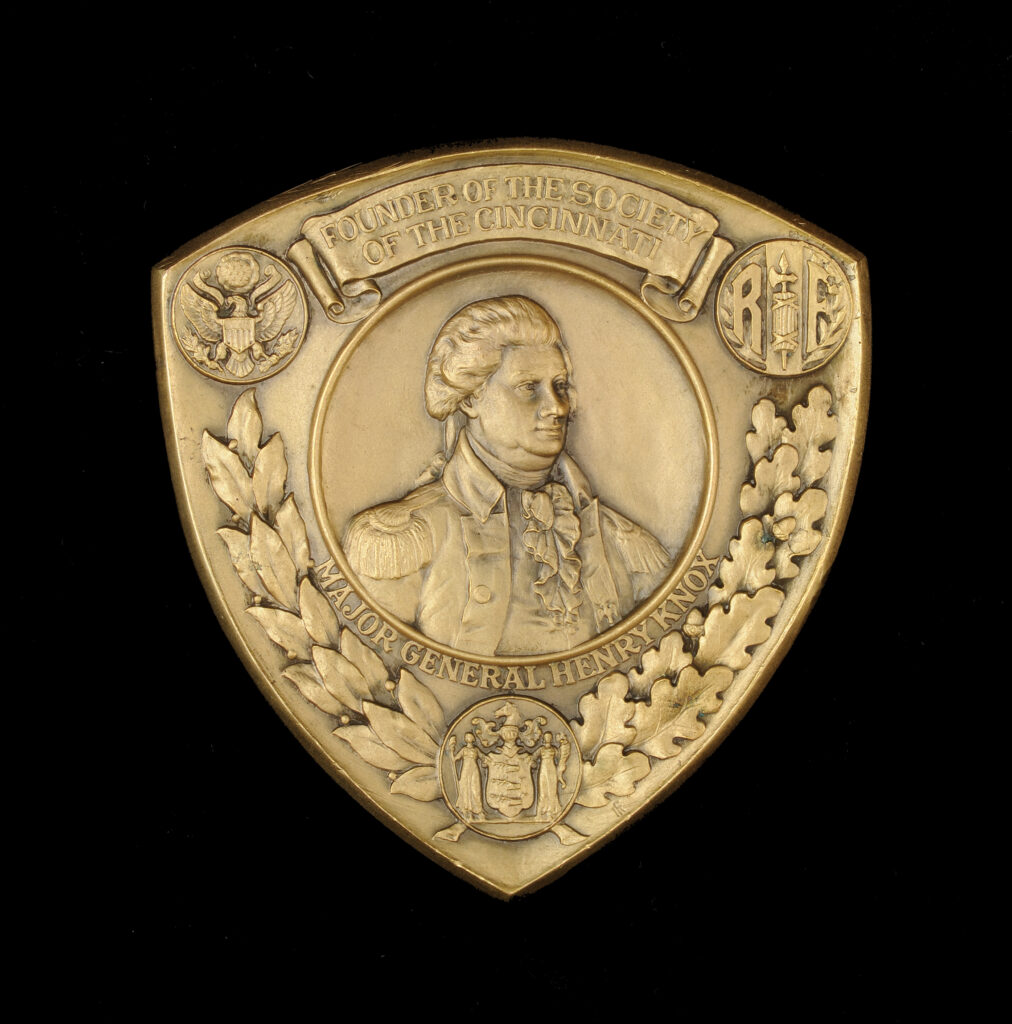
Bailey Banks & Biddle, Philadelphia, Pa.
ca. 1926
Gift of Thomas R. Goethals, Society of the Cincinnati in the State of Connecticut, 1994
The New Jersey Society hosted the 1926 Triennial Meeting in Princeton and commissioned this shield-shaped gilt bronze medal to commemorate the event. The obverse, pictured here, bears a portrait of Henry Knox, the Society’s founder, wearing the Eagle insignia, with the arms of the United States, the Republic of France, and the State of New Jersey in the corners. The reverse depicts the Eagle with rays of sun radiating from the center.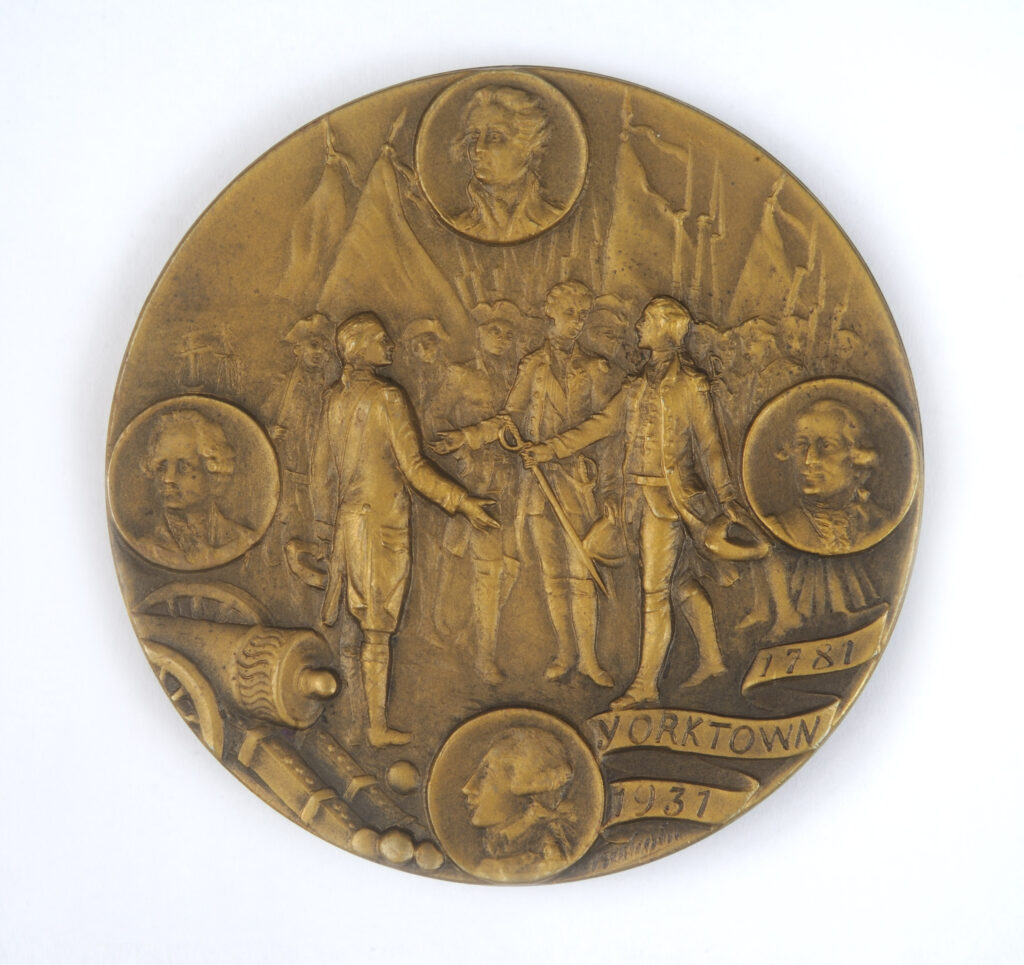
A. Bacqueville, Paris, France
1931
The Society of the Cincinnati Collections
In October 1831, American and French dignitaries led a four-day celebration of the allied victory at Yorktown one hundred and fifty years earlier. The Virginia Society commissioned this bronze medal to commemorate the anniversary. The reverse, pictured here, depicts the British surrender at Yorktown, with circular portraits of George Washington, Admiral de Grasse, the marquis de Lafayette, and General Rochambeau framing the scene. The obverse bears the Eagle of the Society.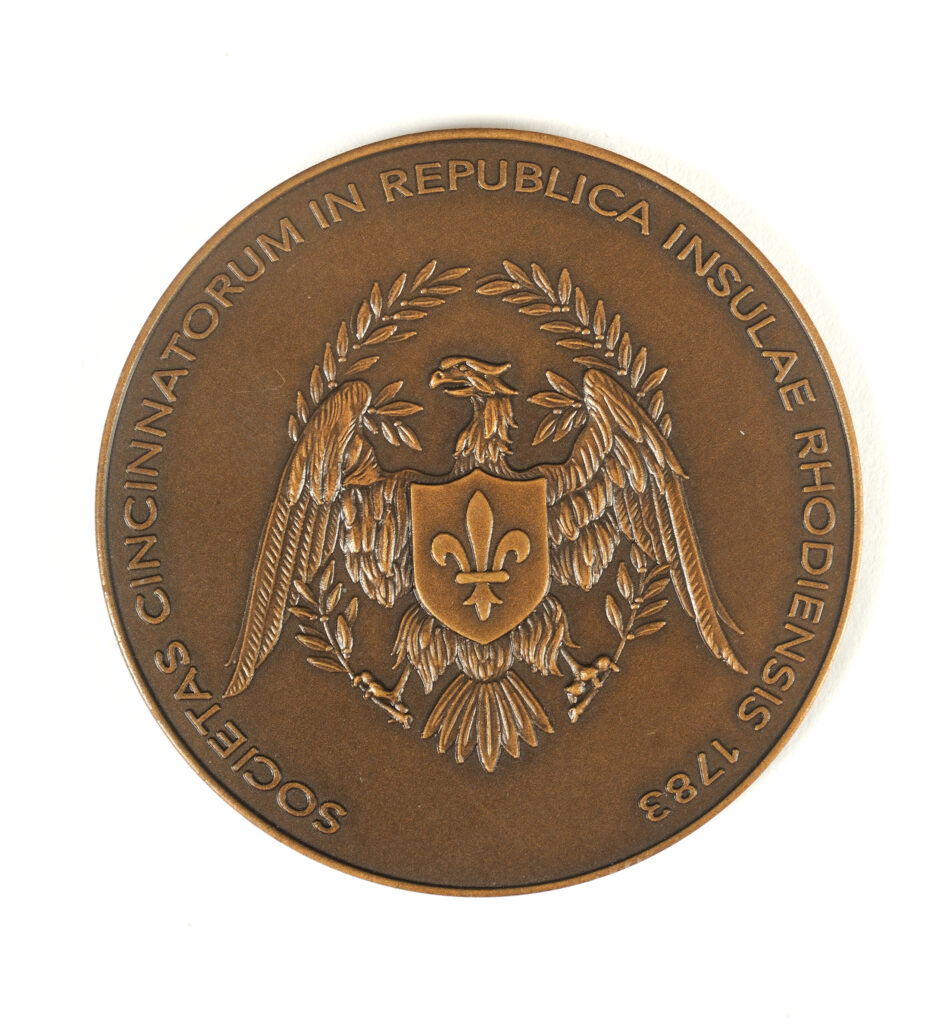
Designed by Henry L. P. Beckwith; Struck by Cleave & Co., London, England
2004
Anonymous gift, 2004
The most recent Triennial medal was commissioned by the Rhode Island Society to mark the 2004 meeting held in Newport. The obverse of the bronze medal, shown here, depicts the arms of the Rhode Island Society: an American bald eagle holding olive boughs with a shield on its chest bearing the fleur-de-lys, symbolizing the Revolutionary War alliance with France. The reverse features commemorative text surrounded by a laurel wreath.